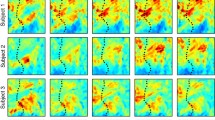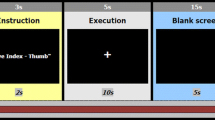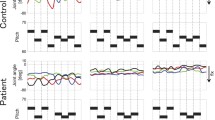Abstract
Using functional magnetic resonance imaging (fMRI), finger representations were characterized in the precentral cortex of 11 normal musicians and 14 musicians with focal task-specific dystonia. Finger representations were identified from differential activation during repetitive movements of each finger relative to others. Despite group similarities in topography, abnormalities in representations of affected fingers were identified. For the finger showing chronic flexion (primary dystonic finger or PDF), the cortical “disparity” from its normal location and the distance to the adjacent finger were increased. By contrast, representational characteristics of the finger showing chronic extension (primary compensatory finger or PCF) did not differ significantly from the control group, but did differ from those of the PDF. Regardless of whether either finger's representation differed substantively from normal, the PCF consistently showed greater volume of activation than the PDF or other fingers. These findings reflect dysfunctional interactions between at least two fingers and their cortical representations.




Similar content being viewed by others
References
Backes, W. H., & van Dijk, P. (2002). Simultaneous sampling of event-related BOLD responses in auditory cortex and brainstem. Magnetic Resonance in Medicine, 47(1), 90–96. doi:10.1002/mrm.10015.
Beisteiner, R., Gartus, A., Erdler, M., Mayer, D., Lanzenberger, R., & Deecke, L. (2004). Magnetoencephalography indicates finger motor somatotopy. The European Journal of Neuroscience, 19(2), 465–472. doi:10.1111/j.1460-9568.2004.03115.x.
Beisteiner, R., Windischberger, C., Lanzenberger, R., Edward, V., Cunnington, R., Erdler, M., et al. (2001). Finger somatotopy in human motor cortex. NeuroImage, 13(6 Pt 1), 1016–1026 see comment. doi:10.1006/nimg.2000.0737.
Bitan, T., Burman, D. D., Lu, D., Cone, N. E., Gitelman, D. R., Mesulam, M. M., et al. (2006). Weaker top-down modulation from the left inferior frontal gyrus in children. NeuroImage, 33(3), 991–998. doi:10.1016/j.neuroimage.2006.07.007.
Black, K. J., Ongur, D., & Perlmutter, J. S. (1998). Putamen volume in idiopathic focal dystonia. Neurology, 51(3), 819–824.
Boroojerdi, B., Foltys, H., Krings, T., Spetzger, U., Thron, A., & Topper, R. (1999). Localization of the motor hand area using transcranial magnetic stimulation and functional magnetic resonance imaging. Clinical Neurophysiology, 110(4), 699–704. doi:10.1016/S1388-2457(98)00027-3.
Butterworth, S., Francis, S., Kelly, E., McGlone, F., Bowtell, R., & Sawle, G. V. (2003). Abnormal cortical sensory activation in dystonia: an fMRI study. Movement Disorders, 18(6), 673–682. doi:10.1002/mds.10416.
Byl, N. N., McKenzie, A., & Nagarajan, S. S. (2000). Differences in somatosensory hand organization in a healthy flutist and a flutist with focal hand dystonia: a case report. Journal of Hand Therapy, 13(4), 302–309.
Byl, N. N., Nagajaran, S., & McKenzie, A. L. (2003). Effect of sensory discrimination training on structure and function in patients with focal hand dystonia: a case series. Archives of Physical Medicine and Rehabilitation, 84(10), 1505–1514. doi:10.1016/S0003-9993(03)00276-4.
Candia, V., Schafer, T., Taub, E., Rau, H., Altenmuller, E., Rockstroh, B., et al. (2002). Sensory motor retuning: a behavioral treatment for focal hand dystonia of pianists and guitarists. Archives of Physical Medicine and Rehabilitation, 83(10), 1342–1348. doi:10.1053/apmr.2002.35094.
Ceballos-Baumann, A. O., & Brooks, D. J. (1997). Basal ganglia function and dysfunction revealed by PET activation studies. Advances in Neurology, 74, 127–139.
Cohen, L. G., & Hallett, M. (1988). Hand cramps: clinical features and electromyographic patterns in a focal dystonia. Neurology, 38(7), 1005–1012.
Dechent, P., & Frahm, J. (2003). Functional somatotopy of finger representations in human primary motor cortex. Human Brain Mapping, 18(4), 272–283. doi:10.1002/hbm.10084.
Delmaire, C., Krainik, A., Tezenas du Montcel, S., Gerardin, E., Meunier, S., Mangin, J. F., et al. (2005). Disorganized somatotopy in the putamen of patients with focal hand dystonia. Neurology, 64(8), 1391–1396.
Delmaire, C., Vidailhet, M., Elbaz, A., Bourdain, F., Bleton, J. P., Sangla, S., et al. (2007). Structural abnormalities in the cerebellum and sensorimotor circuit in writer's cramp. Neurology, 69(4), 376–380 see comment. doi:10.1212/01.wnl.0000266591.49624.1a.
Deuschl, G., Toro, G., Matsumoto, J., & Hallett, M. (1995). Movement-related cortical potentials in writer's cramp. Annals of Neurology, 38, 862–868. doi:10.1002/ana.410380606.
Dresel, C., Castrop, F., Haslinger, B., Wohlschlaeger, A. M., Hennenlotter, A., & Ceballos-Baumann, A. O. (2005). The functional neuroanatomy of coordinated orofacial movements: sparse sampling fMRI of whistling. NeuroImage, 28(3), 588–597. doi:10.1016/j.neuroimage.2005.06.021.
Elbert, T., Candia, V., Altenmuller, E., Rau, H., Sterr, A., Rockstroh, B., et al. (1998). Alteration of digital representations in somatosensory cortex in focal hand dystonia. Neuroreport, 9(16), 3571–3575. doi:10.1097/00001756-199811160-00006.
Fahn, S. (1988). Blepharospasm: a form of focal dystonia. Advances in Neurology, 49, 125–133.
Georgopoulos, A. P., Pellizzer, G., Poliakov, A. V., & Schieber, M. H. (1999). Neural coding of finger and wrist movements. Journal of Computational Neuroscience, 6(3), 279–288. doi:10.1023/A:1008810007672.
Grafton, S. T., Woods, R. P., Mazziotta, J. C., & Phelps, M. E. (1991). Somatotopic mapping of the primary motor cortex in humans: activation studies with cerebral blood flow and positron emission tomography. Journal of Neurophysiology, 66(3), 735–743.
Hall, D. A., Haggard, M. P., Akeroyd, M. A., Palmer, A. R., Summerfield, A. Q., Elliott, M. R., et al. (1999). “Sparse” temporal sampling in auditory fMRI. Human Brain Mapping, 7(3), 213–223. doi:10.1002/(SICI)1097-0193(1999)7:3<213::AID-HBM5>3.0.CO;2-N.
Hallett, M. (1993). Physiology of basal ganglia disorders: an overview. The Canadian Journal of Neurological Sciences, 20(3), 177–183.
Hallett, M. (1998). The neurophysiology of dystonia. Archives of Neurology, 55(5), 601–603. doi:10.1001/archneur.55.5.601.
Hallett, M. (2004). Dystonia: abnormal movements result from loss of inhibition. Advances in Neurology, 94, 1–9.
Hlustik, P., Solodkin, A., Gullapalli, R. P., Noll, D. C., & Small, S. L. (2001). Somatotopy in human primary motor and somatosensory hand representations revisited. Cerebral Cortex (New York, N.Y.), 11(4), 312–321. doi:10.1093/cercor/11.4.312.
Hlustik, P., Solodkin, A., Noll, D. C., & Small, S. L. (2004). Cortical plasticity during three-week motor skill learning. Journal of Clinical Neurophysiology, 21(3), 180–191. doi:10.1097/00004691-200405000-00006.
Ibanez, V., Sadato, N., Karp, B., Deiber, M. P., & Hallett, M. (1999). Deficient activation of the motor cortical network in patients with writer's cramp. Neurology, 53(1), 96–105.
Karbe, H., Holthoff, V. A., Rudolf, J., Herholz, K., & Heiss, W. D. (1992). Positron emission tomography demonstrates frontal cortex and basal ganglia hypometabolism in dystonia. Neurology, 42(8), 1540–1544.
Kleinschmidt, A., Nitschke, M. F., & Frahm, J. (1997). Somatotopy in the human motor cortex hand area. A high-resolution functional MRI study. The European Journal of Neuroscience, 9(10), 2178–2186. doi:10.1111/j.1460-9568.1997.tb01384.x.
Krings, T., Topper, R., Foltys, H., Erberich, S., Sparing, R., Willmes, K., et al. (2000). Cortical activation patterns during complex motor tasks in piano players and control subjects. A functional magnetic resonance imaging study. Neuroscience Letters, 278, 189–193. doi:10.1016/S0304-3940(99)00930-1.
Krumhansl, C. L. (2003). Experimental strategies for understanding the role of experience in music cognition. Annals of the New York Academy of Sciences, 999, 414–428. doi:10.1196/annals.1284.052.
Leijnse, J. N. (1997). Anatomical factors predisposing to focal dystonia in the musician's hand-principles, theoretical examples, clinical significance. Journal of Biomechanics, 30(7), 659–669. doi:10.1016/S0021-9290(97)00008-0.
Lerner, A., Shill, H., Hanakawa, T., Bushara, K., Goldfine, A., & Hallett, M. (2004). Regional cerebral blood flow correlates of the severity of writer's cramp symptoms. NeuroImage, 21(3), 904–913. doi:10.1016/j.neuroimage.2003.10.019.
Lim, V. K., Altenmuller, E., & Bradshaw, J. L. (2001). Focal dystonia: current theories. Human Movement Science, 20(6), 875–914. doi:10.1016/S0167-9457(01)00076-8.
Lotze, M., Erb, M., Flor, H., Huelsmann, E., Godde, B., & Grodd, W. (2000). fMRI evaluation of somatotopic representation in human primary motor cortex. NeuroImage, 11(5 Pt 1), 473–481. doi:10.1006/nimg.2000.0556.
Marsden, C. D., Obeso, J. A., Zarranz, J. J., & Lang, A. E. (1985). The anatomical basis of symptomatic hemidystonia. Brain, 108(Pt 2), 463–483. doi:10.1093/brain/108.2.463.
Meister, I., Krings, T., Foltys, H., Boroojerdi, B., Muller, M., Topper, R., et al. (2005). Effects of long-term practice and task complexity in musicians and nonmusicians performing simple and complex motor tasks: implications for cortical motor organization. Human Brain Mapping, 25(3), 345–352. doi:10.1002/hbm.20112.
Munte, T. F., Altenmuller, E., & Jancke, L. (2002). The musician's brain as a model of neuroplasticity. Nature Reviews. Neuroscience, 3(6), 473–478.
Niyazov, D. M., Butler, A. J., Kadah, Y. M., Epstein, C. M., & Hu, X. P. (2005). Functional magnetic resonance imaging and transcranial magnetic stimulation: effects of motor imagery, movement and coil orientation. Clinical Neurophysiology, 116(7), 1601–1610. doi:10.1016/j.clinph.2005.02.028.
Pantev, C., Engelien, A., Candia, V., & Elbert, T. (2001). Representational cortex in musicians. Plastic alterations in response to musical practice. Annals of the New York Academy of Sciences, 930, 300–314.
Pascual-Leone, A., Nguyet, D., Cohen, L. G., Brasil-Neto, J. P., Cammarota, A., & Hallett, M. (1995). Modulation of muscle responses evoked by transcranial magnetic stimulation during the acquisition of new fine motor skills. Journal of Neurophysiology, 74, 1037–1045.
Peller, M., Zeuner, K. E., Munchau, A., Quartarone, A., Weiss, M., Knutzen, A., et al. (2006). The basal ganglia are hyperactive during the discrimination of tactile stimuli in writer's cramp. Brain, 129(Pt 10), 2697–2708. doi:10.1093/brain/awl181.
Penfield, W., & Rasmussen, T. (1950). Somatomotor responses. In W. Penfield, & T. Rasmussen (Eds.), The Cerebral Cortex of Man (pp. 46–57). New York: Macmillan.
Pujol, J., Roset-Llobet, J., Rosines-Cubells, D., Deus, J., Narberhaus, B., Valls-Sole, J., et al. (2000). Brain cortical activation during guitar-induced hand dystonia studied by functional MRI. NeuroImage, 12(3), 257–267. doi:10.1006/nimg.2000.0615.
Rao, S. M., Binder, J. R., Hammeke, T. A., Bandettini, P. A., Bobholz, J. A., Frost, J. A., et al. (1995). Somatotopic mapping of the human primary motor cortex with functional magnetic resonance imaging. Neurology, 45, 919–924.
Raos, V., Franchi, G., Gallese, V., & Fogassi, L. (2003). Somatotopic organization of the lateral part of area F2 (dorsal premotor cortex) of the macaque monkey. Journal of Neurophysiology, 89(3), 1503–1518. doi:10.1152/jn.00661.2002.
Roberts, T. P., Zusman, E., McDermott, M., Barbaro, N., & Rowley, H. A. (1995). Correlation of functional magnetic source imaging with intraoperative cortical stimulation in neurosurgical patients. Journal of Image Guided Surgery, 1(6), 339–347. doi:10.1002/(SICI)1522-712X(1995)1:6<339::AID-IGS5>3.0.CO;2-B.
Rotte, M., Kanowski, M., & Heinze, H. J. (2002). Functional magnetic resonance imaging for the evaluation of the motor system: primary and secondary brain areas in different motor tasks. Stereotactic and Functional Neurosurgery, 78(1), 3–16. doi:10.1159/000063834.
Sanes, J. N., & Donoghue, J. P. (2000). Plasticity and primary motor cortex. Annual Review of Neuroscience, 23, 393–415. doi:10.1146/annurev.neuro.23.1.393.
Sanes, J. N., Donoghue, J. P., Thangaraj, V., Edelman, R. R., & Warach, S. (1995). Shared neural substrates controlling hand movements in human motor cortex. Science, 268(5218), 1775–1777 see comment. doi:10.1126/science.7792606.
Schieber, M. H. (1999). Somatotopic gradients in the distributed organization of the human primary motor cortex hand area: evidence from small infarcts. Experimental Brain Research, 128(1–2), 139–148. doi:10.1007/s002210050829.
Schieber, M. H. (2001). Constraints on somatotopic organization in the primary motor cortex. Journal of Neurophysiology, 86(5), 2125–2143.
Schieber, M. H., & Hibbard, L. S. (1993). How somatotopic is the motor cortex hand area? Science, 261(5120), 489–492. doi:10.1126/science.8332915.
Schlaug, G., Sanes, J. N., Thangaraj, V., Darby, D. G., Jancke, L., Edelman, R. R., et al. (1996). Cerebral activation covaries with movement rate. Neuroreport, 7(4), 879–883. doi:10.1097/00001756-199603220-00009.
Schwenkreis, P., El Tom, S., Ragert, P., Pleger, B., Tegenthoff, M., & Dinse, H. R. (2007). Assessment of sensorimotor cortical representation asymmetries and motor skills in violin players. The European Journal of Neuroscience, 26(11), 3291–3302. doi:10.1111/j.1460-9568.2007.05894.x.
Shoham, D., & Grinvald, A. (2001). The cortical representation of the hand in macaque and human area S-I: high resolution optical imaging. The Journal of Neuroscience, 21(17), 6820–6835.
Slobounov, S., Chiang, H., Johnston, J., & Ray, W. (2002). Modulated cortical control of individual fingers in experienced musicians: an EEG study. Clinical Neurophysiology, 113(12), 2013–2024. doi:10.1016/S1388-2457(02)00298-5.
Smith, J. F., Chen, K., Johnson, S., Morrone-Strupinsky, J., Reiman, E. M., Nelson, A., et al. (2006). Network analysis of single-subject fMRI during a finger opposition task. NeuroImage, 32, 325–332. doi:10.1016/j.neuroimage.2005.12.010.
Stippich, C., Ochmann, H., & Sartor, K. (2002). Somatotopic mapping of the human primary sensorimotor cortex during motor imagery and motor execution by functional magnetic resonance imaging. Neuroscience Letters, 331(1), 50–54. doi:10.1016/S0304-3940(02)00826-1.
Tempel, L. W., & Perlmutter, J. S. (1993). Abnormal cortical responses in patients with writer's cramp. Neurology, 43(11), 2252–2257 erratum appears in Neurology 1994 Dec;44(12):2411.
Terao, Y., Ugawa, Y., Sakai, K., Miyauchi, S., Fukuda, H., Sasaki, Y., et al. (1998). Localizing the site of magnetic brain stimulation by functional MRI. Experimental Brain Research, 121(2), 145–152. doi:10.1007/s002210050446.
van Westen, D., Fransson, P., Olsrud, J., Rosen, B., Lundborg, G., & Larsson, E. M. (2004). Finger somatotopy in area 3b: an fMRI-study. BMC Neuroscience, 5, 28. doi:10.1186/1471-2202-5-28.
Volkmann, J., Schnitzler, A., Witte, O. W., & Freund, H. (1998). Handedness and asymmetry of hand representation in human motor cortex. Journal of Neurophysiology, 79(4), 2149–2154.
Woolsey, C. N., Erickson, T. C., & Gilson, W. E. (1979). Localization in somatic sensory and motor areas of human cerebral cortex as determined by direct recording of evoked potentials and electrical stimulation. Journal of Neurosurgery, 51(4), 476–506.
Zhuang, P., Li, Y., & Hallett, M. (2004). Neuronal activity in the basal ganglia and thalamus in patients with dystonia. Clinical Neurophysiology, 115(11), 2542–2557. doi:10.1016/j.clinph.2004.06.006.
Author information
Authors and Affiliations
Corresponding author
Rights and permissions
About this article
Cite this article
Burman, D.D., Lie-Nemeth, T., Brandfonbrener, A.G. et al. Altered Finger Representations in Sensorimotor Cortex of Musicians with Focal Dystonia: Precentral Cortex. Brain Imaging and Behavior 3, 10–23 (2009). https://doi.org/10.1007/s11682-008-9046-z
Received:
Accepted:
Published:
Issue Date:
DOI: https://doi.org/10.1007/s11682-008-9046-z




